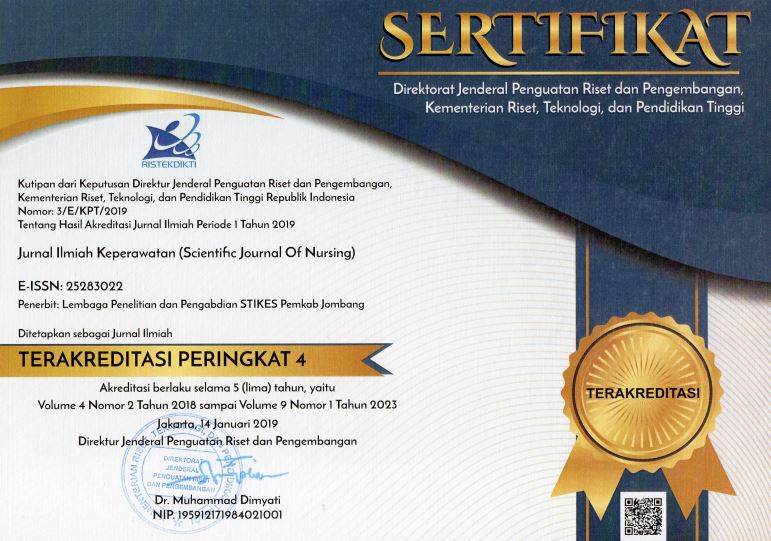HUBUNGAN TINGKAT KESEPIAN DENGAN PSYCHOLOGICAL WELL-BEING PADA LANSIA DI WILAYAH KERJA PUSKESMAS ALAHAN PANJANG
Relationship between Loneliness and Psychological Well-Being in Elderly in Alahan Panjang Health Center
DOI:
https://doi.org/10.33023/jikep.v10i2.2155Keywords:
loneliness, elderly, psychological well beingAbstract
Pendahuluan: Kesepian adalah pengalaman subjektif yang dapat dirasakan siapa saja termasuk lansia. Kesepian dapat berimbas pada kesehatan, penurunan ADL dan berefek pada kualitas hidup lansia. Tujuan: penelitan ini melihat hubungan tingkat kesepian dengan psychological well-being pada lansia di Jorong Galagah. Metode: penelitian ini menggunakan kuantitatif dengan desain penelitian adalah cross sectional. Populasi penelitian ini adalah lansia di Jorong Galagah dengan jumlah sampel 178 responden. Analisa data menggunakan uji spearman rank. Hasil uji analitik korelasi spearman rank menunjukkan dengan tingkat kepercayaan 95% atau p<? (0,05) (Ha diterima). Hasil: Uji statistik diperoleh sig 2 tailed = 0,000 (p<0,05), dengan Nilai r = - 0,733 menunjukkan bahwa dari dari total 178 Jiwa responden lansia, di peroleh data yaitu 33,7 % atau 60 jiwa responden lansia mengalami kesepian pada tingkat ringan dan 49,45 % atau 88 jiwa responden lansia mengalami Physicological Well Being pada tingkat sedang. Kesimpulan: ada hubungan antara kesepian dengan Physicological Well Being pada lansia di jorong galagah wilayah kerja puskesmas Alahan Panjang dan terdapat kolerasi yang kuat antara variabel Kesepian dengan variabel physicological well being dengan arah hubungan negatif yang mana semakin tinggi nilai variabel kesepian maka semakin rendah variabel physicological well being, sebaliknya semakin rendah nilai variabel kesepian maka semakin tinggi variabel physicological well being. Dari hasil dapat di kembangkan menjadi salah satu bentuk pendidikan kesehatan cara pencegahan kesepian agar tidak terjadi kepada lansia
Downloads
References
Aryono, M. M., & Dani, R. A. (2019). Kesepian Dan Kesejahteraan Psikologis Pada Lansia Yang Memilih Melajang. Proyeksi, 14 (2)(2656–4173), 10.
Barnes, T. L., MacLeod, S., Tkatch, R., Ahuja, M., Albright, L., Schaeffer, J. A., & Yeh, C. S. (2022). Cumulative effect of loneliness and social isolation on health outcomes among older adults. Aging and Mental Health, 26(7), 1327–1334. https://doi.org/10.1080/13607863.2021.1940096
Barreto, M., Victor, C., Hammond, C., Eccles, A., Richins, M. T., & Qualter, P. (2021). Loneliness around the world: Age, gender, and cultural differences in loneliness. Personality and Individual Differences, 169. https://doi.org/10.1016/j.paid.2020.110066
Beutel, M. E., Klein, E. M., Brähler, E., Reiner, I., Jünger, C., Michal, M., Wiltink, J., Wild, P. S., Münzel, T., Lackner, K. J., & Tibubos, A. N. (2017). Loneliness in the general population: Prevalence, determinants and relations to mental health. BMC Psychiatry, 17(1). https://doi.org/10.1186/s12888-017-1262-x
Caldwell, M. A., & Peplau, L. A. (1978). Loneliness: A Cognitive Analysis. Essence, 2(4), 207–220.
Chang, M. Y., Chen, C. H., & Huang, K. F. (2008). Effects of music therapy on psychological health of women during pregnancy. Journal of Clinical Nursing, 17(19), 2580–2587. https://doi.org/10.1111/j.1365-2702.2007.02064.x
Cunningham, C., O’ Sullivan, R., Caserotti, P., & Tully, M. A. (2020). Consequences of physical inactivity in older adults: A systematic review of reviews and meta-analyses. Scandinavian Journal of Medicine and Science in Sports, 30(5), 816–827. https://doi.org/10.1111/sms.13616
Ebersol and Hess’. (2014). Gerontological Nursing & Healthy Aging (Mosby (ed.); Fourth Edi).
Holt-Lunstad, J., & Steptoe, A. (2022). Social isolation: An underappreciated determinant of physical health. Current Opinion in Psychology, 43, 232–237. https://doi.org/10.1016/j.copsyc.2021.07.012
Karademas, E. C. (2007). Positive and negative aspects of well-being: Common and specific predictors. Personality and Individual Differences, 43(2), 277–287. https://doi.org/10.1016/j.paid.2006.11.031
Landeiro, F., Barrows, P., Nuttall Musson, E., Gray, A. M., & Leal, J. (2017). Reducing social isolation and loneliness in older people: A systematic review protocol. BMJ Open, 7(5). https://doi.org/10.1136/bmjopen-2016-013778
Leigh-Hunt, N., Bagguley, D., Bash, K., Turner, V., Turnbull, S., Valtorta, N., & Caan, W. (2017). An overview of systematic reviews on the public health consequences of social isolation and loneliness. Public Health, 152, 157–171. https://doi.org/10.1016/j.puhe.2017.07.035
Lim, L. L., & Kua, E. H. (2011). Living alone, loneliness, and psychological well-being of older persons in Singapore. Current Gerontology and Geriatrics Research, 2011. https://doi.org/10.1155/2011/673181
Mishra, B., Pradhan, J., & Dhaka, S. (2023). Identifying the impact of social isolation and loneliness on psychological well-being among the elderly in old-age homes of India: the mediating role of gender, marital status, and education. BMC Geriatrics, 23(1), 1–13. https://doi.org/10.1186/s12877-023-04384-1
Perissinotto, C. M., Stijacic Cenzer, I., & Covinsky, K. E. (2012). Loneliness in Older Persons. Archives of Internal Medicine, 172(14). https://doi.org/10.1001/archinternmed.2012.1993
Prameswari, T. P., Chotidjah, S., & Wyandini, D. Z. (2023). Pengaruh Fear of Missing Out dan Kesepian terhadap Psychological Well-Being pada Remaja Akhir Pengguna Media Sosial Twitter di Jawa Barat. Jurnal Psikologi Insight, 6(1), 1–8. https://doi.org/10.17509/insight.v6i1.64668
Riadi, M. (2019). Pengertian, Aspek dan Penyebab Kesepian (Loneliness). Agustus 09, 2019.
Sadler, W. A., & Weiss, R. S. (1975). Loneliness: The Experience of Emotional and Social Isolation. Contemporary Sociology, 4(2), 171. https://doi.org/10.2307/2062224
Theeke, L. A. (2009). Predictors of Loneliness in U.S. Adults Over Age Sixty-Five. Archives of Psychiatric Nursing, 23(5), 387–396. https://doi.org/10.1016/j.apnu.2008.11.002
Published
How to Cite
Issue
Section
Authors who publish with Jurnal Ilmiah Keperawatan (Scientific Journal of Nursing) agree to the following terms:
- Authors retain copyright and grant Jurnal Ilmiah Keperawatan (Scientific Journal of Nursing) the right of first publication with the work simultaneously licensed under a Creative Commons Attribution 4.0 International License that allows others to remix, adapt and build upon the work with an acknowledgment of the work's authorship and of the initial publication in Jurnal Ilmiah Keperawatan (Scientific Journal of Nursing).
- Authors are permitted to copy and redistribute the journal's published version of the work (e.g., post it to an institutional repository or publish it in a book), with an acknowledgment of its initial publication in Jurnal Ilmiah Keperawatan (Scientific Journal of Nursing).









